Remaining Fantasy XVI is a stellar sport that captures practically every little thing I like about FF

These days, there’s been fairly a little bit of debate about what it means to be a “Remaining Fantasy sport.” For some, which means a standard turn-based RPG. For others, that’s a boring system that requires a shift to real-time fight, a lot to the chagrin of the previous group.
As somebody who’s been taking part in Remaining Fantasy video games for greater than half his life, I’ve heard these arguments for fairly some time. But it surely’s with the enduring Sq. Enix sequence’ newest entry, Remaining Fantasy XVI, that I’ve seen arguably probably the most controversy. In some camps, the transition to full-blown motion is a bridge too far, whereas others bemoan the dearth of a very open world, compelling aspect actions, and a racially numerous lineup of characters. Worse nonetheless, there are those that proclaim that XVI doesn’t really feel like a Remaining Fantasy sport.
Whereas I perceive and even agree with a few of these criticisms, I push again closely towards the notion that this isn’t a Remaining Fantasy sport. Certainly, Naoki Yoshida’s Artistic Enterprise Unit III, the Sq. Enix division behind XVI and the beloved XIV MMORPG, very clearly has a deep reverence for the ever-changing Remaining Fantasy sequence. And although Yoshida serves solely as a producer on XVI, that very same ardour he exudes in XIV may be felt all through, from the honest and gripping narrative and characters to the outstanding music and visuals — all core staples of a Remaining Fantasy sport. There’s way more right here than simply loving nods to Black Mages, Chocobos and traditional Dragoon poses. All of the whereas, CBU III introduces a fight system that’s completely masterful, creating one of many most interesting motion experiences in current reminiscence. With all of this comes a well-rounded package deal that ranks among the many sequence’ greatest whereas additionally pushing it ahead in daring, significant methods.
Rather more than a Recreation of Thrones pastiche
Spiritually, XVI hearkens again to the FFs of previous with a purely medieval fantasy setting, Valisthea, following the futuristic sci-fi world of XIII and pseudo-modern locales of XV. Taking unabashed inspiration from Recreation of Thrones, XVI‘s flavour of old style backdrop is quintessentially European — a lot in order that Sq. Enix employed actors completely from the continent so as to add to the authenticity. However to the purpose of mixing previous and new, XVI does what few different FFs have completed and commits to nuanced, considerate localization, as led by XIV veteran Michael-Christopher Koji Fox. Earlier FFs have considerably awkwardly been translated to the West with unnatural-sounding dialogue, however XVI, in the best possible method doable, feels prefer it could possibly be at house with a big-budget English HBO manufacturing.
Crucially, although, that isn’t used as a crutch, however reasonably to boost the central narrative, which is already sturdy in its personal proper. The sport begins with a prolonged part by which we observe Clive Rosfield, a dutiful younger nobleman tasked with defending his brother Joshua, a ‘Dominant’ able to summoning the {powerful} Phoenix Eikon. Nevertheless, a vicious assault on their kingdom units Clive on a path of vengeance, which, in flip, drags him into a bigger conflict involving Dominants from all nations.

The early days earlier than Clive suffers unspeakable tragedy.
Admittedly, XVI‘s story is one among two disparate halves. The primary is an earnest need to discover themes of oppression which, sadly, don’t really feel totally fleshed out over the course of the 40-hour marketing campaign. That the sport completely options Caucasian protagonists solely makes the inelegant depiction of slaves — represented right here by means of folks generally known as ‘Bearers’ who’re feared for his or her magical skills — really feel all of the extra clumsy. The sport’s bigger commentary on local weather change, replete with Eikons serving as metaphors for nuclear weapons, doesn’t fare significantly better.
Having stated that, there’s been some chatter about Remaining Fantasy XVI‘s story successfully being about Clive and different “white Europeans discovering that slavery is improper,” and that, to me, is such a irritating misreading of all of it. Positive, it’s utterly truthful to criticize the sport for its dealing with of this subject material, however the extra hyperbolic of feedback as seen above — or others claiming XVI is a Recreation of Thrones-level mix of gratuitous violence, profanity and intercourse — are reductive and do a disservice to the precise quite a few strengths of XVI‘s writing.
Above all else, Clive’s story is demonstrably not about discovering that slavery is unhealthy, however reasonably, one among self-discovery. What begins off as a typical revenge quest reveals itself to be a much more fascinating fable about overcoming trauma. It’s about how an inherently kind-hearted man, as soon as loyal to his brother, father, and other people at giant, finds himself so totally damaged and stuffed with self-loathing earlier than slowly studying the right way to love once more — the right way to be cherished once more. Impressively, it’s each a shifting character arc and a loving tribute to the prototypical taciturn Remaining Fantasy protagonist.
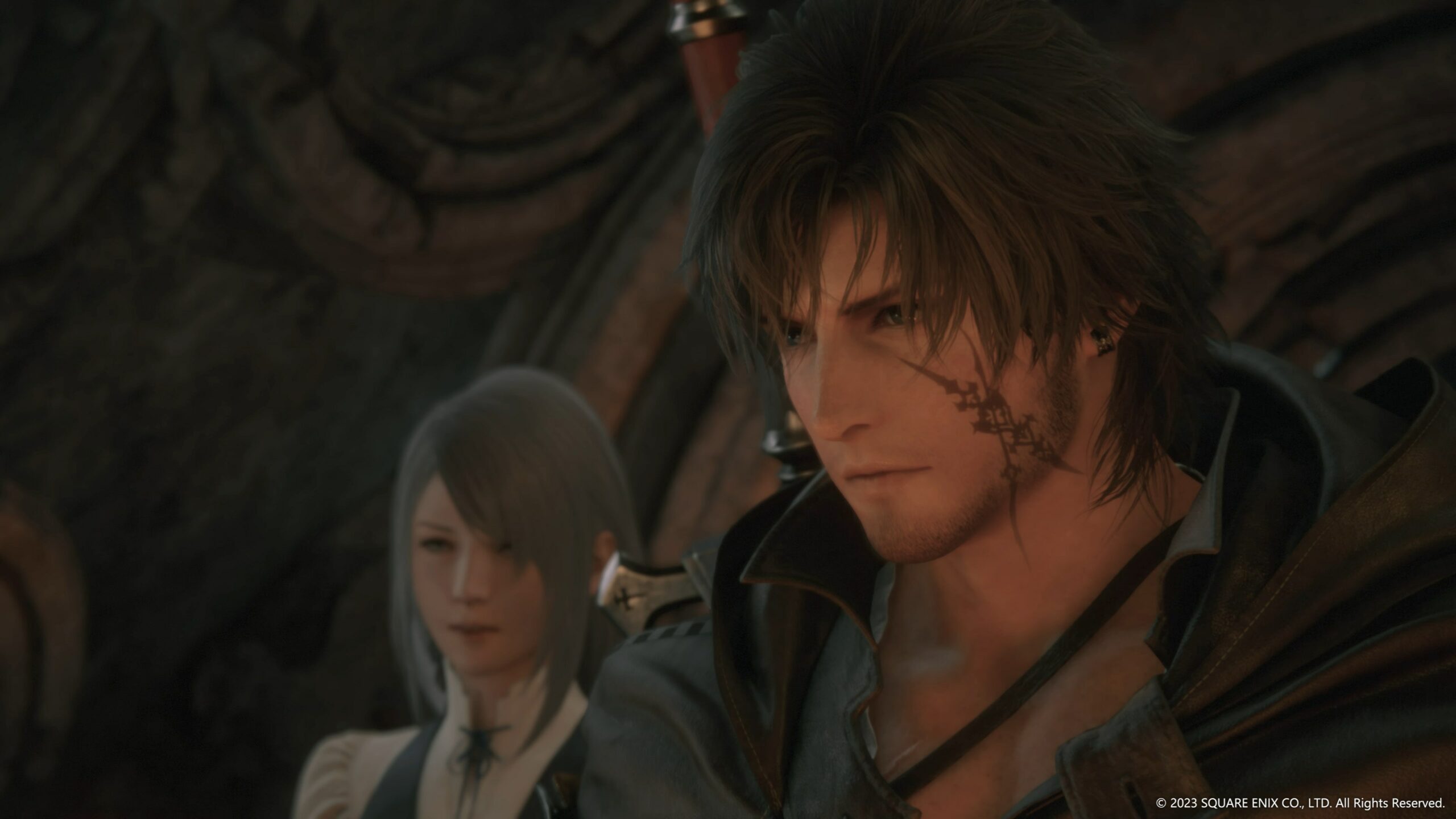
Clive is one among Remaining Fantasy’s greatest characters.
However in contrast to, say, VII‘s Cloud or VIII‘s Squall, XVI advantages from a chilling prolonged prologue that shortly establishes the foundation of our protagonist’s ache upfront, exhibiting us the person Clive as soon as was and rooting us within the journey he should take to reclaim that identification. On this method, XVI makes Clive the sequence’ greatest protagonist since Cloud whereas additionally giving him his personal distinguishable persona. Certainly, a lot of the fantastic thing about XVI‘s narrative lies in its quietest moments, permitting Clive to revisit the previous with family members and exude the compassion buried deep inside, be that by reconnecting with childhood buddy, Jill, bonding with a bloodied soldier in a ditch, or taking the time to playfully educate some rascally youngsters. Throughout all of those scenes, be they gruelling or tender, Ben Starr delivers a fully mesmerizing efficiency, solidifying himself because the clear performing frontrunner come awards time.
By means of Clive, XVI feels, at its coronary heart, extra like a so-called “true” Remaining Fantasy than among the most up-to-date numbered entries. The central cause why I’ve at all times cherished this sequence, above another, is due to precisely this form of earnest and relatable characterization. We see that in VI with Celes, an Imperial turncoat who struggles with loneliness and melancholy. We see that in VII with Cloud, a fierce warrior whose chilly exterior shields profound, on a regular basis insecurities. We see that in IX with Vivi, a lovable little lad who has to grapple with weighty existential questions at such a younger age. Ever for the reason that sequence shifted in direction of extra refined storytelling in its fourth entry by means of protagonist Cecil Harvey’s story of redemption, Remaining Fantasy has at all times been about empathy, and nowhere is that higher exemplified than Clive.
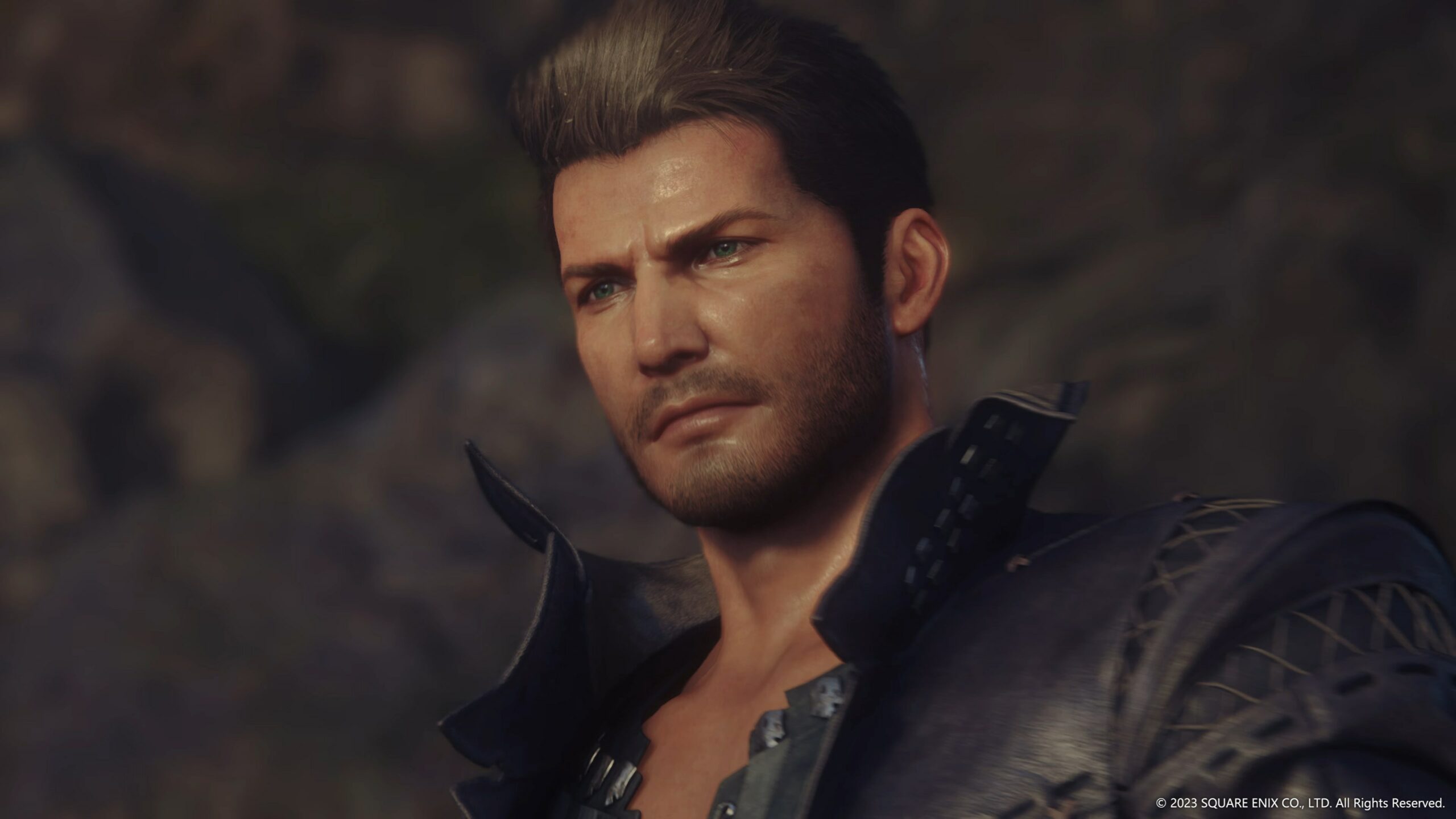
Just about each Remaining Fantasy sport has a Cid, however XVI’s is arguably the easiest.
Better nonetheless, XVI extends that love and care to its stable supporting forged. There’s the lovable rogue Cid, who evokes Clive and a band of different outlaws to combat again towards the oppressors and combat for a brand new world, all with a pleasant Yorkshire accent. There’s Benedikta, the sultry commander whose shared historical past with Cid reveals a troubled previous. There’s Mid, the bubbling younger engineer who helps hold Cid’s operation working. Even seemingly one-note characters, just like the emo lordling Prince Dion or Cid’s endearingly buffoonish scout Gav, get their very own compelling arcs within the latter half of the sport. The sharp writing and top-notch performances all through carry each one among these characters to life, making Valisthea really feel like some of the lived-in and actual settings in a Remaining Fantasy sport up to now. Better of all: ‘Energetic Time Lore,’ which helps you to maintain a button to carry up related glossary data on characters and areas featured or talked about in cutscenes — a fully sensible and novel characteristic that extra video games must undertake.
However mockingly, maybe the most important testomony to XVI “incomes” its place as an FF sport is that it falls into the sequence entice of devolving into the extra outlandish and nonsensical in direction of the tip, introducing new threats and conflicts far much less fascinating than these offered within the earlier hours. It’s a testomony to the standard of the characters and worldbuilding that such twists don’t derail the whole sport, but it surely’s nonetheless unlucky that the sport didn’t hone in on the much more fascinating ideological and political strife as a substitute of the unusual pivot to supernatural foes.
Clive Could Cry (over the unimaginable fight)
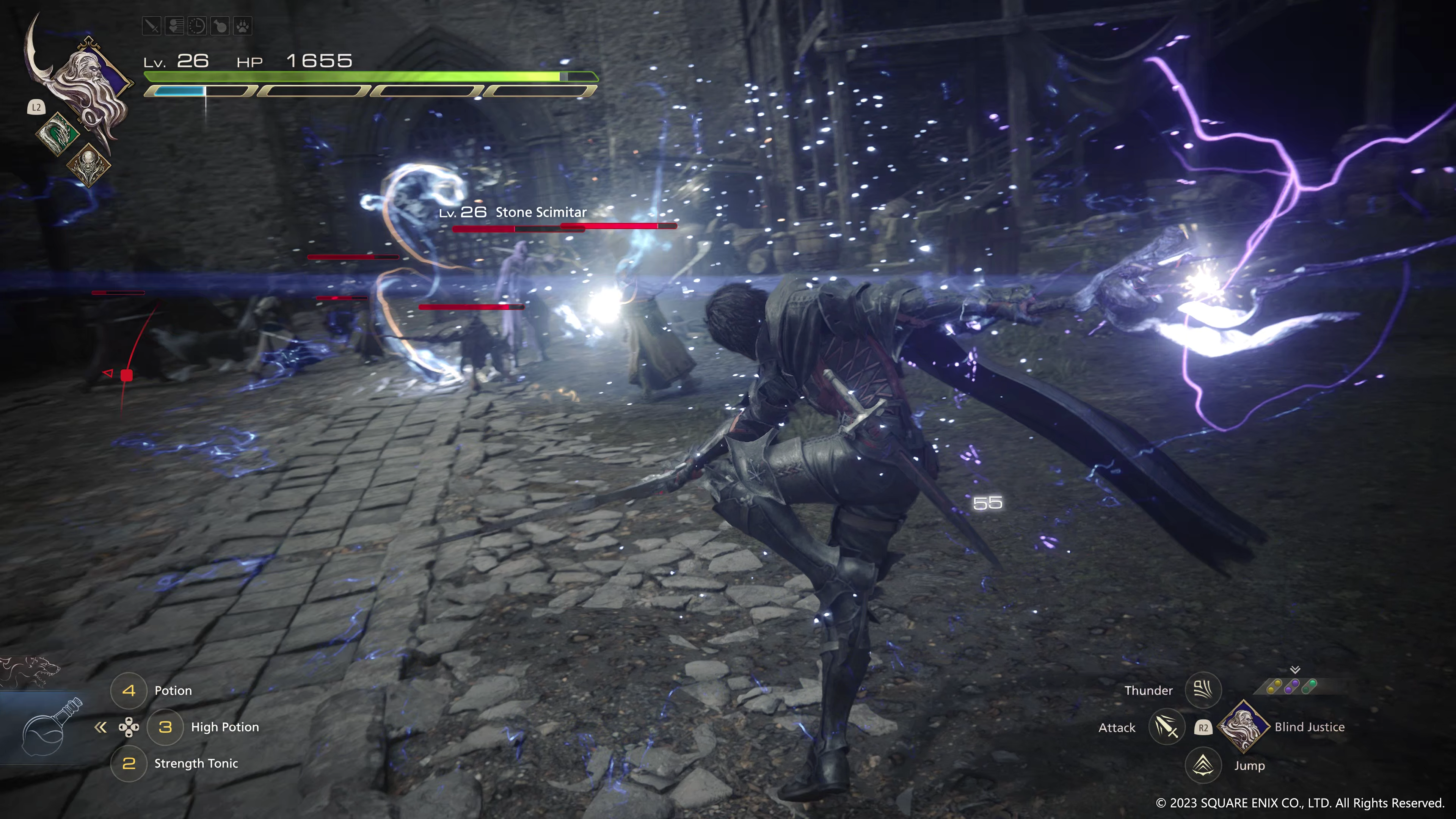
XVI’s fight is as gripping as it’s flashy.
On the deserves of its mature story and characters alone, XVI is price taking part in, however the sport has way more to it even when none of that appeals to you. As beforehand talked about, that is inherently an motion sport — a lot so, in truth, that CBU III tapped Satan Could Cry 5 and Dragon’s Dogma alum Ryota Suzuki to function lead fight designer. And boy, do these influences present.
At face worth, XVI definitely does look rather a lot like these motion video games. With sword in hand, Clive can hack, slash, twirl, and even leap cancel his method by means of battles with the extent of ridiculous stylishness you’d count on from DMC‘s Dante. And positive sufficient, particularly expert gamers can positively string collectively advanced, prolonged combos so as to add layers to the flashiness.
However what’s most spectacular about XVI‘s fight system is its versatility, each by way of Clive’s arsenal and its participant approachability as an entire. With respect to the latter, Sq. Enix has admirably added a ‘Story Centered’ mode and assistive equipment that simplify fight by means of automated dodges, streamlined combos, and extra. For folks coming into XVI who aren’t used to the likes of DMC, these are glorious choices to have, though they’re sadly not correct accessibility options for these with disabilities.
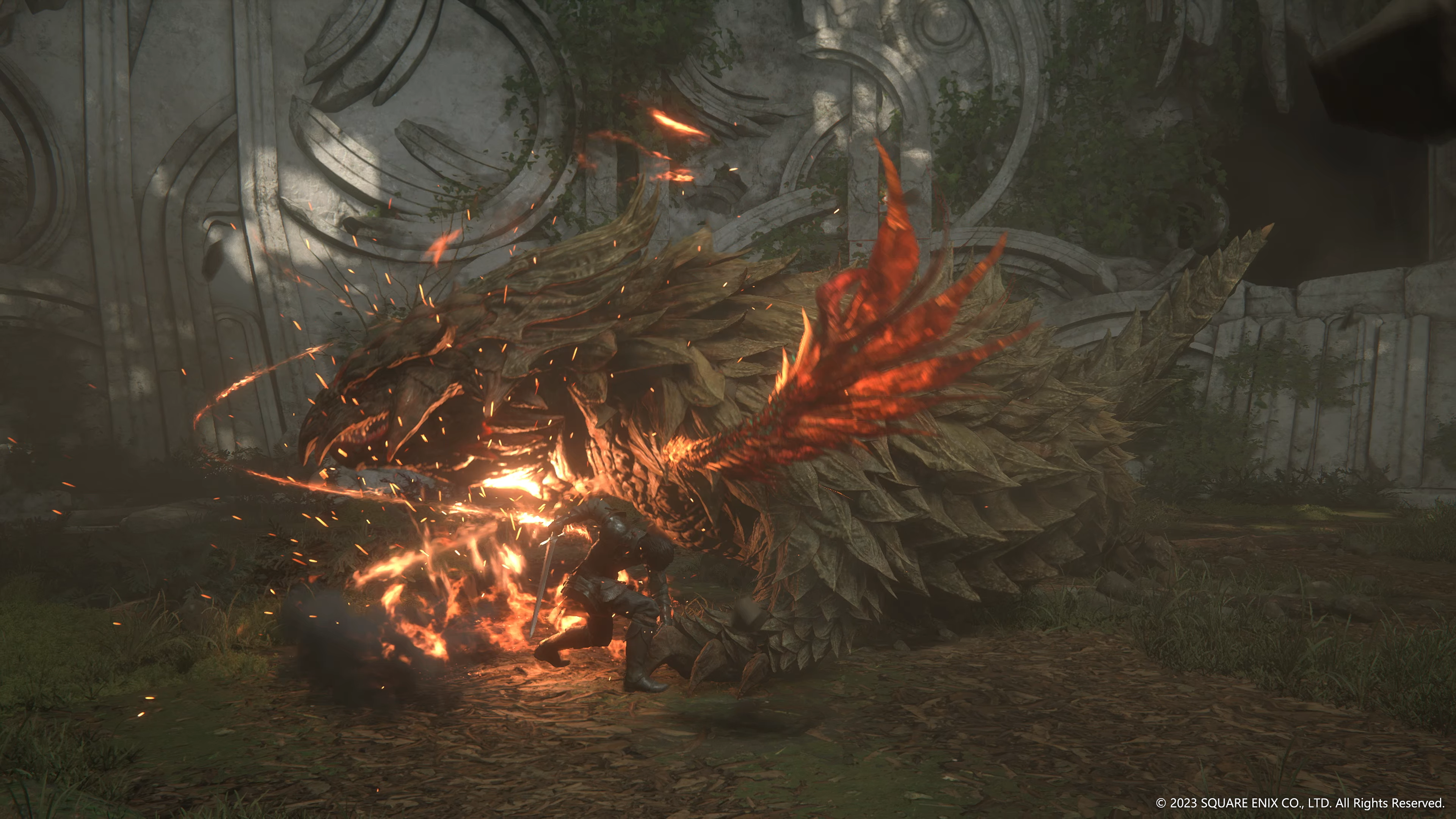
One-Winged Angel.
XVI has what’s simply one among my favorite fight programs up to now. It’s sturdy sufficient to allow you to play it like a DMC if you happen to so select, however for the much less technical gamers, like myself, it nonetheless has oodles of depth. That’s as a result of XVI incorporates the sequence’ greatest use of summons (“Eikons”) up to now. Rather than prolonged summoning cutscenes à la traditional FFs and even XV or short-term AI-controlled allies as in VII Remake, XVI‘s Eikons are all about their customization.
Due to Joshua’s blessing, Clive is ready to wield among the Phoenix’s powers, which give him particular strikes within the type of some fiery wing-based dashes and strikes. Since these function on a cooldown, your choices are pretty restricted in the beginning. However earlier than lengthy, you’ll achieve new Eikonic skills from different Dominants, comparable to Benedikta’s wind-based Garuda and the ruthless Hugo’s rock-centric Titan. Every Eikon has its personal small ability tree by means of which you need to use Potential Factors accrued by means of levelling to accumulate new skills and grasp previous ones.
As such, XVI has “loadouts” of types, incentivizing you to routinely experiment with Eikon configurations. Graciously, any mastered capability may be outfitted to any Eikon set, so you may combine and match strikes with out being locked to any explicit Eikon. On the similar time, XVI solely lets you equip three units at a time, so it’s important to be a bit extra considerate in the way you strategy them. I’ll confess that this felt frustratingly limiting at first, however I quickly appreciated that it added a stage of technique to fight and, by means of that, made me respect every Eikon’s distinctive strengths all of the extra. In actual fact, these customization choices are the place the sport most appears like an RPG, because the precise development programs — together with a painfully linear gear improve system that’s nearly completely unlocked alongside the story — go away a lot to be desired. Whereas I want you had extra selection within the varieties of drugs you may unlock, the mix of radically completely different Eikons and a set of equipment to boost every of their particular person skills a minimum of felt fairly rewarding.

These fists have been made for pummeling, and that’s simply what they’ll do.
As an illustration, I adored how Titan’s Raging Fists assault pummels enemies with comically outsized rocky fists whereas additionally providing a parry performance to extend its effectiveness. On the flip aspect, Odin’s Gungnir capability does far much less injury however unleashes a balletic flurry of spear slices and strokes to fill a ‘Zantetsuken’ gauge for an omnipotent ending transfer. Every transfer has its personal cooldown, making a euphoric sense of freedom as I seamlessly swapped between Eikon units on the fly. A specific favorite was utilizing Garuda’s Aerial Blast to conjure up a sluggish however lethal twister to ensnare a gaggle of enemies after which swap to Phoenix’s Flames of Rebirth to pummel them with a pillar of flames. XVI is a fairly beautiful sport all through, but it surely’s in these types of magical assaults — the smokey little embers encircling a plume of charcoal smoke — that the visuals grow to be really spellbinding. (It additionally has some of the constant 30fps modes I’ve ever seen with nearly no dips in any respect, so I truly performed on the 4K Decision Mode to completely take pleasure in all the splendor.)
If that weren’t sufficient, XVI has simply the sequence’ most sizeable enemy selection up to now, providing intelligent reimaginings of traditional FF creatures just like the poisonous and tentacled plant-like Malboros and snarling, fanged Behemoths whereas throwing in twists on conventional implausible beasts like trolls and wolves. But it surely’s the boss fights which can be, indisputably, XVI‘s biggest achievement on the gameplay entrance. Conventional boss encounters towards monsters or magical people are all nice in their very own proper, and that’s earlier than we even get to the Godzilla-esque Eikon fights.
Sure, XVI lets Clive tackle the type of the horned fireplace demon Ifrit to battle different huge Eikons, and this leads to, bar none, among the greatest boss fights I’ve ever seen in a sport. The sense of awe in discovering the ever-escalating scope of those Kaiju-inspired clashes — taking us from the bottom to the sky and even outer area and again with earth-shattering power — by no means ceases to amaze, and it makes the inevitable Dominant encounters really feel all of the extra thrilling. To say an excessive amount of extra about these would spoil the numerous jaw-dropping, cheer-worthy moments discovered all through, however suffice it to say that every Eikon skirmish is extremely memorable and thrilling. The one challenge is a few of these depend on the occasional dated Fast-Time Occasion (QTE), however fortunately, the majority of those Eikon battles are totally interactive. Complementing all of that is XIV composer Masayoshi Soken’s chic rating, which mixes grand operatic symphonies with badass guitar and vocal items to make every boss really feel much more rousing. The best way Soken splendidly mixes majestic new items with lovely homages to traditional Nobuo Uematsu scores from the likes of unique Remaining Fantasy to Remaining Fantasy VIII is nothing wanting magical.

By some means, Eikon battles get even greater than this.
The one space by which fight really falls quick is thru its “occasion system.” I take advantage of citation marks as a result of you might have completely zero affect over the characters who’re with you, significantly Torgal, Clive’s lovable wolf companion who accompanies him for the majority of the sport. Given the motion focus, it’s not inherently an issue to solely instantly management Clive, however the lack of ability to a minimum of customise Torgal, Jill and different allies with whom you’ll spend many hours in battle feels maddeningly restrictive. Calling this a “occasion” with out permitting for even probably the most primary of customization choices appears like low cost lip service to an FF sequence staple. Even one thing like Sq. Enix’s Kingdom Hearts sequence lets you gear up and tweak the AI behaviour of your mates, and XVI would have benefited from providing one thing related.
A small however compelling world
Throughout the press tour for XVI, CBU III has been candid about how XVI isn’t an open-world sport. For me, that isn’t truly a foul factor in any respect. Far too many fashionable video games get sucked into that framework as if to verify off an inventory, affected by bloat in consequence. That stated, this implies you continue to must do one thing purposeful with the smaller explorable areas you create, and therein lies XVI‘s biggest failing.
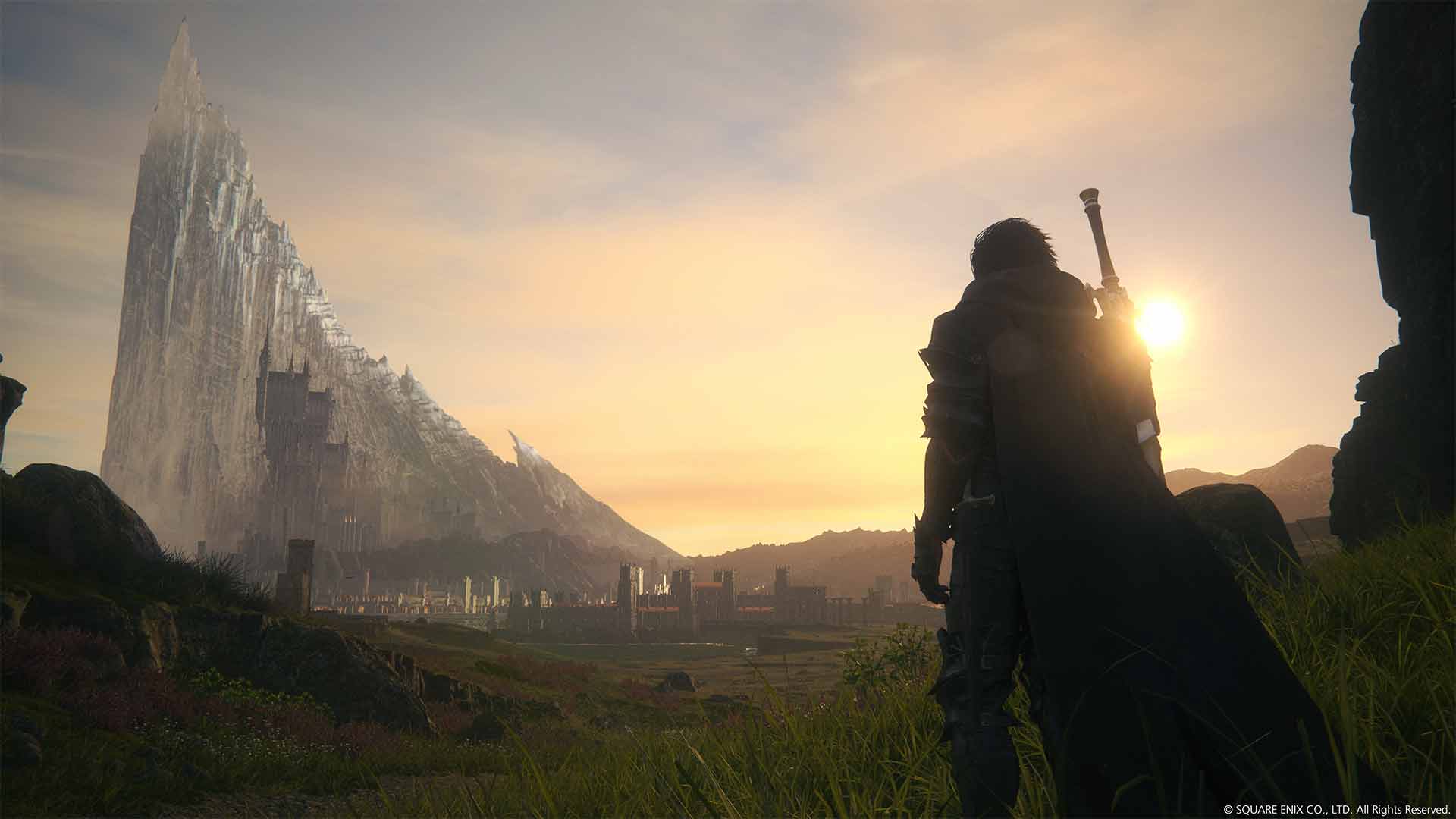
XVI is a beautiful sport.
Merely put, far too many areas in XVI really feel expansive only for the sake of it, providing completely no actual incentive to traverse by means of them past getting from Level A to B. The occasional chest or merchandise might be positioned all through, however these are minor rewards that don’t meaningfully add depth to those barren environments. That is maybe greatest exemplified in a single late-game part; I got here throughout a small village overrun by enemies, so naturally, I made some extent of searching down and felling every one. By the tip of that, although, I discovered nothing besides a few chests with some primary crafting substances for the sport’s aforementioned rudimentary gear system. What may have been a possibility to find an unmarked sidequest, explorable homes and even non-obligatory dialogue was as a substitute ostensibly simply filler for the map, and that’s the form of factor you see typically in XVI‘s locales.
With such shallow stage design, your solely different cause for returning to areas and venturing out additional is the sport’s many sidequests. Nevertheless, these, too, really feel undercooked; I’d wager that the primary few dozen of those are your customary, rote “go kill this enemy” or “fetch this merchandise.” Whereas usually well-written from a dialogue perspective, they’re in any other case woefully missing any actual meat. If nothing else, XVI cordially marks sidequests that unlock helpful options like Chocobo driving and elevated merchandise efficiency with a plus signal, so you may focus your consideration on these.
And to their credit score, XVI‘s sidequests grow to be way more fascinating as you progress by means of the marketing campaign. Ultimately, you’ll uncover extra emotionally-charged and character-driven items, like discovering out about Cid’s uncouth service provider Charon’s checkered previous or serving to beleaguered townspeople rebuild their house. One significantly healthful sidequest concerned Clive and Torgal revisiting their previous, and it had me in tears as somebody who lately misplaced his canine.
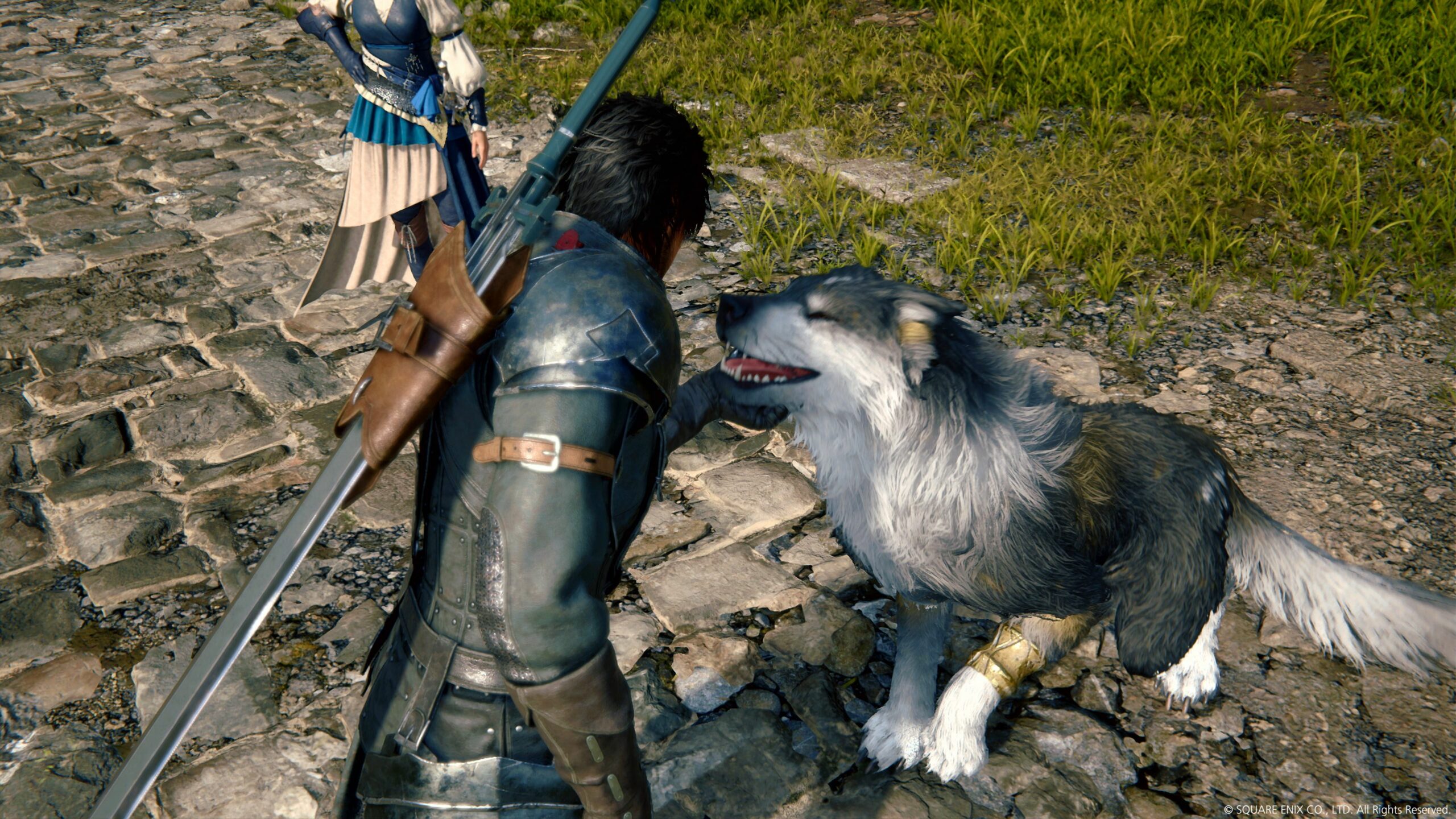
Torgal is an efficient boy.
It’s by means of these late-game sidequests that XVI‘s non-obligatory content material in the end proves worthwhile. In between missions, you come to Cid’s hideaway, a bustling hub that homes his allies and different downtrodden people. Lots of the sidequests relate to those characters, deepening your bond with them accordingly. It places a human face to XVI‘s broader battle, reminding you of what Clive is combating for within the course of. Not for the reason that Mass Impact sequence have I felt so desperate to return to a hub space to verify in with all the NPCs, so fleshed out and likable as all of them are. This sense of group that Clive fosters is, in some ways, the beating coronary heart of XVI, and I felt a deeper emotional attachment to the entire gang in consequence.
A brand new type of fantasy
Amid all the discourse surrounding this sport and the which means of Remaining Fantasy as an entire, I’m reminded of why I like this sequence within the first place. Whereas folks really feel an FF sport ought to solely be this or that, I principally simply respect the anthological nature of all of it. For greater than 35 years, Remaining Fantasy has endured due to its capability to redefine itself with every entry, taking huge dangers and daring swings the place many franchises wouldn’t.
With Remaining Fantasy XVI, Artistic Enterprise Unit III has gone for an expertise that’s each grittier in tone and narrative and extra over-the-top and snazzy in gameplay. That strategy definitely doesn’t attraction to everybody, but it surely’s one which completely works for me. True, XVI doesn’t at all times attain its lofty ambitions, however at its core lies a totally heartfelt story crammed with excellent characters and a masterful fight system that’s totally participating and enrapturing. It’s concurrently fantastically trustworthy to the spirit of Remaining Fantasy and one thing refreshingly distinct, and I wouldn’t have it another method.
Remaining Fantasy XVI is now out there on PlayStation 5. A free demo is out there on the PlayStation Retailer, and progress may be carried over to the ultimate product.
Picture credit score: Sq. Enix


